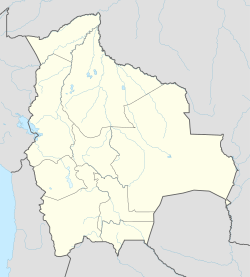Luribay Municipality
Luribay Municipality | |
|---|---|
Municipality | |
| Coordinates: 17°0′0″S 67°35′0″W / 17.00000°S 67.58333°W | |
| Country | |
| Department | La Paz Department |
| Province | Loayza Province |
| Seat | Luribay |
| Government | |
| • Mayor | Lucho Quispe Chino (2007) |
| Area | |
• Total | 194 sq mi (503 km2) |
| Elevation | 10,000 ft (3,000 m) |
| Population (2001) | |
• Total | 9,004 |
| Time zone | UTC-4 (BOT) |
Luribay Municipality is the first municipal section of the Loayza Province in the La Paz Department of Bolivia. Encompassing an area of approximately 506.3 km2 (195.5 sq mi), it had a population of 10,581 in March 2024. The town of Luribay serves as the administrative center of the municipality. Situated in the inter-Andean valleys, it is characterized by a dry climate and fertile soils, making it particularly suitable for certain agricultural activities and known for its wine and singani production.
History
[edit]Luribay's history is deeply intertwined with the development of viticulture in Bolivia. The cultivation of grapes and the production of wine in Luribay date back to the colonial period, introduced by the Spanish.[1]
Geography
[edit]The municipality spans about 506.3 km2 (195.5 sq mi) within the Loayza Province in the La Paz Department.[2] The district consists of the main urban center of the town of Luribay and multiple villages.[3] It is situated in the inter-Andean valleys (valles interandinos), a geographical zone between the higher altitudes of the Altiplano and the lower tropical plains. It has a landscape of valleys and slopes, contrasting with the high-altitude plains of the Altiplano and the flat expanses of the Amazonian lowlands.[4] The toown of Luribay is located at 2,546 m (8,353 ft), while nearby mountain village of Anchallani is located at 4,187 m (13,737 ft).[5][6] The municipality is part of a region known for its dry climate and fertile soils.[1] The municipality incorporates several high mountains.[7][8][9]
Demographics
[edit]Encompassing an area of approximately 506.3 km2 (195.5 sq mi), the district had a population of 10,581 in March 2024. The population consisted of 5,685 males, and 5,454 females with a 92% literacy rate.[10] The economy is predominantly agricultural, with diverse crop cultivation. In addition to wine, Luribay is also known for producing singani, a traditional Bolivian grape brandy.[1][4]
See also
[edit]References
[edit]- ^ a b c "El vino boliviano busca expandirse en el mercado internacional". AméricaEconomía. Retrieved 30 June 2025.
- ^ "Luribay Municip ality boundaries". CityPopulation.de. Retrieved 17 June 2025.
- ^ "Census list" (PDF). INSAE census booklet. Retrieved 17 June 2025.
- ^ a b "Luribay". Bolivia.travel. Retrieved 30 June 2025.
- ^ "Luribay". DB‑City.com. Retrieved 17 June 2025.
- ^ "Anchallani". DB‑City.com. Retrieved 17 June 2025.
- ^ IGM map 1:50,000 6042-II Sicasica
- ^ IGM map 1:50,000 6042-I Luribay
- ^ "Luribay". INE, Bolivia. Archived from the original on 15 February 2016. Retrieved February 9, 2016.
- ^ "Luribay". CityPopulation.de. Retrieved 17 June 2025.


